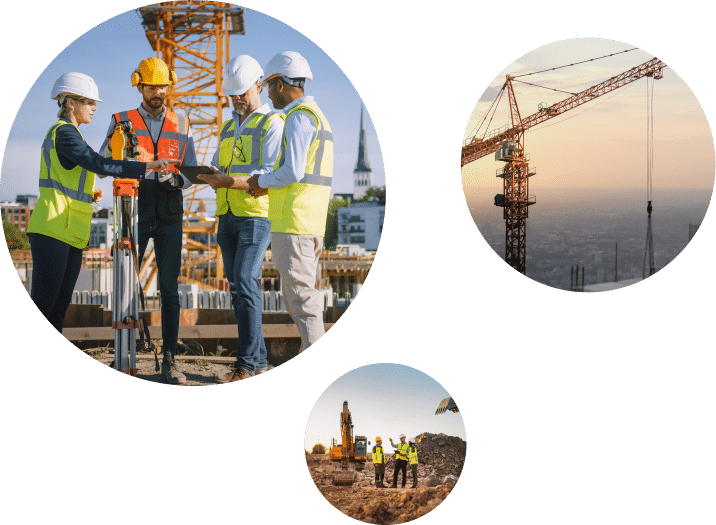Blog > Guides
Toolbox Talk Essentials
15 Ideas for Safety Discussions
Safety on the jobsite should be priority No. 1 for every contractor firm, as well as any company within the construction ecosystem. Businesses should constantly think of strategies to keep their people as safe and secure as possible.

This safety focus is simply a responsible way to deal with the realities of construction risks. Employees will appreciate that their employers are looking out for them, and there are obvious regulatory and efficiency benefits to running the safest possible jobsite.
Toolbox talks represent one of the tactics businesses can use to emphasize safety. These group discussions, spearheaded by the workers in the field, bring specific safety measures and concepts to life. By emphasizing safe practices within the day-to-day process of working, toolbox talks can make these beneficial work styles feel like second nature.

What Is a Toolbox Talk?
A toolbox talk is a relatively informal safety refresher, a brief safety talk among workers to make sure everyone is on the same page about an important issue. Toolbox talks don’t take long or require complex course materials. They simply help ensure safety topics are fresh in workers’ minds.
Construction supervisors can choose to include a safety toolbox talk as part of their daily briefing for employees at the start of a shift. This daily cadence allows leaders to consistently touch on new areas and concepts. Choices can be topical, based on something relevant to the job at hand or focused on evergreen safety knowledge.
Toolbox talks require little investment or advance planning. Since crew supervisors handle each toolbox meeting themselves instead of deferring to outside instructors, there’s no deviation from the standard work schedule. The impact is to focus all employees’ attention on concepts that can truly matter in terms of their day-to-day well-being.
There’s no limit to the types of subjects that can be part of a safety talk at a toolbox meeting. Leaders can deal with all aspects of employee health — physical or mental — as well as equipment use, preparation, teamwork and more. Over the course of months, toolbox talk topics will add up to a multifaceted refresher on construction safety.
Why Are Toolbox Talks So Important?
The importance of a toolbox talk is twofold. First, it passes on useful safety information that will help workers look after their physical and mental health. Second, it sets a positive tone for the workday to come and ensures safety is part of the workplace culture on a jobsite.
A safety focus is absolutely essential in construction, where the hands-on nature of the work raises the possibility of accidents on the jobsite. The most recent Construction Industry Institute report indicates that the annual fatality rate per 100,000 workers has ticked subtly up, from 0.99 to 1.34. Keeping this and similar measures low is part of a shared duty across the construction sector.
The causes of the 11 recorded fatalities among CII members included contact with equipment, falls and transportation incidents. Safety toolbox talks can address all of these priorities, along with other topics. Some of those alternative subjects are lighter in nature, while others are more subtle but can still lead to danger over time.
A comprehensive variety of subjects and a regular toolbox talk cadence can promote safety as a core value for a contractor, which is a positive differentiator.

15 Ideas for Safety Toolbox Talks
Any subject related to construction safety and health can become a topic for a toolbox talk. That means leaders have a nearly unlimited variety of subjects to tackle. This potential for exploration can be a little intimidating — with so many options, where’s the best place to start?
The following 15 ideas can be useful starting points, helping construction managers pick diverse topics for their morning discussions as they aim to produce a safety culture:
1. Stretching to prevent everyday injuries:
Sometimes, the most impactful injury prevention practices are the simplest. Stretching muscles before starting work for the day is a way to minimize the chances of small injuries that can damage productivity, cause ongoing discomfort or lead to bigger risks. Learn more about stretch-and-flex programs.
2. Protecting against noise:
Many pieces of construction equipment are loud, which makes ear protection an essential piece of personal protective equipment (PPE). There are also other hearing-protection strategies for construction crews to try, including placing the loudest tools behind barriers and investing in quieter modern offerings. Discover how to block out harmful noise on jobsites.
3. Avoiding exposure to harmful substances:
Some safety best practices for construction sites are subtle and less obvious. These include minimizing exposure to carcinogens on the jobsite, such as from silica dust or diesel exhaust. Taking care of these health risks through effective hazard communication can have a positive long-term health impact. Uncover carcinogen exposure reduction and other underrated safety practices.
4. Preventing falls from heights:
Fall prevention is a relevant safety topic due to the prevalence of high-elevation work across the construction industry. Best practices for workers in these situations are important, as is the proper, safe use of PPE and edge-guarding equipment on jobsites. Ladder safety is a related injury prevention area also worth mentioning. Go inside the process of safe work around heights.
5. Using technology in safety planning:
Digital tools make advanced safety planning processes accessible to small and medium construction firms, allowing these businesses to monitor safety on the site without consultants or large departments. Training in high-level use of these systems can come with major workplace safety benefits for these companies. See the capabilities of a digital safety assessment tool.
6. Preserving mental health on the jobsite:
Mental health strain doesn’t come with the same external scars as a physical injury, and therefore it can be harder to detect. Teaching employees to recognize and deal with mental health problems before they become too severe is therefore a valuable safety toolbox talk topic. Learn about how construction firms can prioritize mental well-being.
7. Wearing advanced protective gear:
Construction PPE has evolved over time. Learning about innovations in gear and implementing these new assets on the jobsite can help a construction crew strengthen its workplace safety record. A toolbox talk meeting is a useful forum to promote correct, safe use of PPE. View the features of next-generation construction hard hats.
8. Coping with heat risk in the summer:
Extreme temperatures are a recurring threat in many parts of the world, exacerbated by the effects of climate change. Creating safe working conditions in the midst of severe heat requires new best practices as well as the use of specialized equipment. Figure out how crews are dealing with jobsite heat.
9. Staying clean to avoid contaminants:
There are multiple steps involved with managing exposure to substances like lead. Workers need to be aware of the contamination risk on any jobsite they work on, and they also have to have access to thorough cleansing procedures and all related equipment. See top solutions for contaminant risks in construction.
10. Dealing with disrupted routines due to remote work:
Routines can promote health and safety in construction or any industry, so it’s worth asking what happens when those patterns are disrupted. With teams now scattered geographically due to hybrid workstyles, it’s worth measuring the effect on communication, organization and more, as well as office safety. See how construction pros are coping with remote work.
11. Engaging in safety planning at a small business:
Small contractor firms have to take a great deal of responsibility for developing workplace health and safety programs that suit their employees. It’s useful to spend some time going over the relevant best practices, to make sure these companies make the most of their limited personnel. Check out a sample process for small business safety program development.
12. Managing a safe flow of people and materials:
The organization and layout of a jobsite — with safely demarcated routes for people and vehicles and intelligently positioned inventory — can have an impact on safety. The more carefully a project is mapped, the safer workers will be moving around the site. Take a closer look at jobsite organization and logistics.
13. Wearing smart tech devices to promote safety:
Smart devices are as common today as personal fitness trackers. The same concept behind these consumer electronics, namely that it’s useful to view real-time data from the body, can make them a valuable piece of a tech-enabled jobsite safety program. Discover the current state of smart devices integrated with PPE.
14. Identifying hazards at the design stage:
The design of a structure can determine how safe it will be as a finished building — and also how safe it is to work on. When architects think about construction logistics in the design stage, they can create a positive experience for the crews that will work on their projects. Find out more about safety considerations for architects.
15. Managing site inspections via drone:
When construction workers have access to drones, they can take potentially hazardous work away from ground-bound crews. Of course, to use drones effectively for inspections and other jobs on the jobsite, personnel will need to become skilled operators. Get an overview of drones on the jobsite.
Ready To Commit to Everyday Safety Practices?
So many of the daily responsibilities on a construction site carry safety implications. Correct PPE use, careful navigation around heavy machinery, noise control, fall prevention, protection against heat and more — all these are worth discussing and strengthening.
Toolbox talks are one of the mechanisms a contractor firm can use to create a safety culture at a day-to-day level. Safety measures can become part of a company’s DNA, beginning with design and planning and extending through the lifespan of every job.
Technology has an important role to play in keeping jobsites safe. To learn more about running a well-organized jobsite, watch our webinar on the subject.
Discover how digital collaboration boosts jobsite safety.






